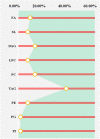Serum Untargeted UHPLC-HRMS-Based Lipidomics to Discover the Potential Biomarker of Colorectal Advanced Adenoma
- PMID: 34858060
- PMCID: PMC8632617
- DOI: 10.2147/CMAR.S336322
Serum Untargeted UHPLC-HRMS-Based Lipidomics to Discover the Potential Biomarker of Colorectal Advanced Adenoma
Abstract
Background: As a key precancerous lesion, colorectal advanced adenoma (CAA) is closely related to the occurrence and development of colorectal cancer (CRC). Effective identification of CAA-related biomarkers can prevent CRC morbidity and mortality. Lipids, as an important endogenous substance, have been proved to be involved in the occurrence and development of CRC. Lipidomics is an advanced technique that studies lipid metabolism and biomarkers of diseases. However, there are no lipidomics studies based on large serum samples to explore diagnostic biomarkers for CAA.
Methods: An integrated serum lipid profile from 50 normal (NR) and 46 CAA subjects was performed using ultra-high performance liquid chromatography tandem high-resolution mass spectrometry (UHPLC-HRMS). Lipidomic data were acquired for negative and positive ionization modes, respectively. Differential lipids were selected by univariate and multivariate statistics analyses. A receiver operator characteristic curve (ROC) analysis was conducted to evaluate the diagnostic performance of differential lipids.
Results: A total of 53 differential lipids were obtained by combining univariate and multivariate statistical analyses (P < 0.05 and VIP > 1). In addition, 12 differential lipids showed good diagnostic performance (AUC > 0.90) for the discrimination of NR and CAA by receiver operating characteristic curve (ROC) analysis. Of them, the performance of PC 44:5 and PC 35:6e presented the outstanding performance (AUC = 1.00, (95% CI, 1.00-1.00)). Moreover, triglyceride (TAG) had the highest proportion (37.74%) as the major dysregulated lipids in the CAA.
Conclusion: This is the first study that profiled serum lipidomics and explored lipid biomarkers with good diagnostic ability of CAA to contribute to the early prevention of CRC. Twelve differential lipids that effectively discriminate between NR and CAA serve as the potential diagnostic markers of CAA. An obvious perturbation of TAG metabolism could be involved in the CAA formation.
Keywords: UHPLC-HRMS; biomarker; colorectal advanced adenoma; colorectal cancer; serum lipidomics.
© 2021 Zhu et al.
Conflict of interest statement
The authors declare that they have no known competing financial interests or personal relationships that could have appeared to influence the work reported in this paper.
Figures








References
-
- Sung H, Ferlay J, Siegel RL, et al. Global cancer statistics 2020: GLOBOCAN estimates of incidence and mortality worldwide for 36 cancers in 185 countries. CA Cancer J Clin. 2021;71:209–249. - PubMed
-
- Aepli P, Criblez D, Baumeler S, et al. Endoscopic full thickness resection (EFTR) of colorectal neoplasms with the Full Thickness Resection Device (FTRD): clinical experience from two tertiary referral centers in Switzerland. United Eur Gastroenterol J. 2018;6:463–470. doi:10.1177/2050640617728001 - DOI - PMC - PubMed
LinkOut - more resources
Full Text Sources
Research Materials

